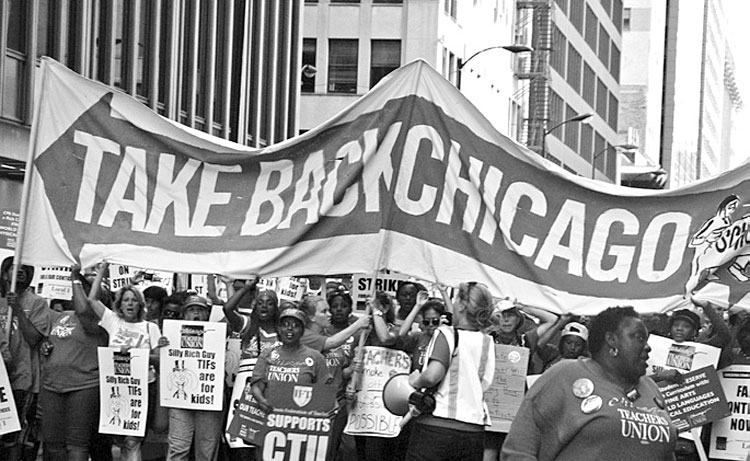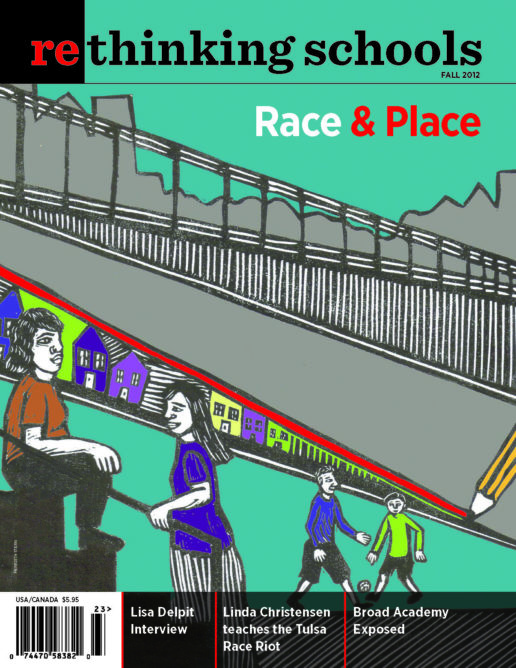Taking the Long View: The Organizing Tradition
Illustrator: Chicago Teachers Union

(PHOTO CREDIT: CHICAGO TEACHERS UNION)
As we go to press, 30,000 Chicago teachers and education support personnel—joined by parents, students, and community members—are out on strike for the first time in 25 years. The first day of the strike, downtown Chicago was a sea of red (the color of the Chicago Teachers Union T-shirts) as an estimated 50,000 people massed for a support rally.
Whatever the final result, the Chicago teachers’ ability to take on not only the powerful local political structure, but also the national forces backing corporate education reform, is a testament to the justice of their demands and the impact of grassroots organizing: years of work done school by school, community by community. We hope that the mobilization in Chicago—electric with defiance and democracy—signals the start of a revitalized movement in defense of public education and the communities it serves.
We write this knowing that not every battle for education justice has gone well this year. Teachers, parents, students, and communities have suffered some well-publicized setbacks in recent months.
In Wisconsin, right-wing Republican Gov. Scott Walker—fueled by Koch brothers’ money—beat back a grassroots recall campaign. Teachers are now retooling their organizing plans, given the loss of most union rights and in the midst of a funding crisis that has left Wisconsin schools bereft of essential resources.
In Tucson, the school board, faced with a state law inspired by anti-Latina/o sentiment, abolished the district’s Mexican American Studies (MAS) program—in the face of massive community protest and a national campaign in defense of MAS. The district removed all books associated with the MAS curriculum and banned their use by MAS teachers.
Of course setbacks like these matter. But it’s important not to lose sight of the bigger picture: the long-term impact of organizing people and communities. People involved in struggles for education justice change their own lives and make our movements stronger. When teachers in Milwaukee went door-to-door in the neighborhoods surrounding their schools, when they initiated conversations with Hmong elders in their own language, they were echoing, and often directly inspired by, an approach to social change popularized by the Civil Rights Movement. Civil rights activists like Bob Moses and Ella Baker of the Student Nonviolent Coordinating Committee promoted what became known as the organizing tradition. Rather than focusing on the role of charismatic leaders, those operating within the organizing tradition are animated by the conviction that “ordinary people” can change the world. Movements lead to deep, and deeply humane, social change by nurturing and expanding the role of each participant, and forging collaborative relationships that engender shared wisdom and effective action. The results of that kind of work don’t disappear because an election is lost or a school board acts out of cowardice and ignorance.
Re-imagining the Union in Milwaukee
The corporate education agenda demeans and expunges the role of democratic processes in education—through mandating scripted curricula, abolishing elected school boards, dismantling collective bargaining, casting parents in the role of passive educational consumers, and promoting charter schools and vouchers unhinged from meaningful public accountability.
In contrast, defenders of public education work to enlarge the role of democratic practices in solving problems. For example, in Milwaukee, the Milwaukee Teachers’ Education Association (MTEA) has responded to the Walker strategy by initiating a campaign to “re-imagine and re-invent” the union. Chief among its goals are invigorating rank-and-file participation, building new alliances with parents and communities, and reclaiming the profession to combat the move toward test-driven, scripted curriculum. Members are encouraged to step forward as leaders and take on new “advocate” roles within the union. These advocates will help the MTEA move away from a client model, in which teachers rely on union staff services, to a new model in which staff and teachers are actively involved in union activities. Advocates mobilize their peers to become politically engaged in public school issues, support parent involvement, address social justice issues relevant to students and school communities, and develop new pedagogy and curricula.
In Tucson, Rooted in History
According to longtime Tucson education activist Miguel Ortega, not only is defense of the MAS program rooted in community involvement, the program itself grew out of—and celebrates—a long history of grassroots activism. As Ortega told journalist Jeff Biggers in a recent interview:
During the ’90s, we always tried to incorporate the teaching of local history in everything we organized. This was especially important when we worked with Chicano youth because we wanted them to relate to local, organic heroes and demystify the possibility of them doing the same work as leaders themselves.
And it worked. MAS students and alumni have exercised their democratic responsibilities with amazing commitment. They have played a prominent role in nearly every school board meeting for the last four years. They have responded to the attacks on their history and education through art, theater, and music. Since the MAS program was closed down in January, protest has continued. Tucson Freedom Summer organized a national corps of volunteers to canvass Latina/o neighborhoods and held community encuentros—forums on such topics as bilingual education, educational inequities encountered by Latina/o youth, and the school-to-prison pipeline. Encuentros have continued into the fall, as well as a free Sunday school program of MAS curriculum and pedagogy at a local youth center.
Spotlight on Chicago
As recent events have shown, Chicago is at the epicenter of resistance to corporate school “reform”—that resistance exemplifies the potential of the organizing tradition. Last April, Stand for Children and Chicago’s Mayor Rahm Emanuel pushed through Illinois SB 7, a law requiring that 75 percent of all Chicago teachers vote “yes” to authorize the union to call a strike vote. But the corporate reformers failed to recognize the anger of teachers and communities that have faced one attack after another. Or the impact of great organizing.
In 2010, the Caucus of Rank and File Educators (CORE) swept the leadership of the Chicago Teachers Union (CTU). CORE built its reputation allying with parents and neighborhood organizations to fight school closures. Since then, the CTU has focused on building an activist union structure, strengthening its connections to parents and communities, and articulating a research-driven, equity-centered education program. The CTU is part of one citywide coalition to oppose the district’s plans to close neighborhood schools and replace them with charter and contract schools, and another coalition that has succeeded in getting a referendum on the ballot to reinstate an elected school board.
SB 7 seemed like a devastatingly successful attack on the growing strength and new vision of the CTU. But when negotiations with the district were at a standstill in June, the CTU called a rally and strike vote. More than 6,000 teachers showed up at the rally, and 90 percent of all CTU members (98 percent of those who cast ballots) voted to give the union authority to call a strike. A revitalized teachers’ union, along with parents, students, and community members, is standing up to the assault on public education, energizing teachers nationally and internationally. The CTU website (ctunet.com) lists pledges of solidarity from across the United States and as far away as France, Australia, Mauritius, and Catalonia.
Passing the Torch
Young people have emerged as critically important participants in these struggles. In Madison, Wisconsin, high school students streamed out of the schools to be among the first of those occupying the state capitol to protest Walker’s anti-union legislation. In Milwaukee, the student group Youth Empowered in the Struggle (YES) demonstrated for immigrant rights, fought for in-state tuition for undocumented students, and advocated for a comprehensive student bill of rights. This summer, an extraordinary group of undocumented youth traveled across the country on the No Papers, No Fear UndocuBus to demand human and civil rights for immigrants.
The enthusiastic participation of Chicago youth in the teachers’ strike is a potent example of welcoming students into movements for education change. Adults need to empathize with and learn from youth, even when they challenge our own long-established beliefs. Our mentoring needs to connect young people with traditions of struggle in ways that help them articulate their own values, sensibilities, and aspirations.
Long-term, digging-in-deep organizing is most possible and most effective when it is knit together by the understanding that efforts to transform society toward greater equity are closely bound up with efforts to transform ourselves. It can mean developing new skills and taking on new responsibilities. It means the hard work of constant learning—seeking to understand how we can change classroom and political dynamics to make our schools better able to meet the needs of all students. It means learning to listen to and empathize with those whose life experience and outlook differ from our own, and being brave enough to disagree with friends and challenge political opponents. Such work, alternately frustrating and satisfying, makes our movement stronger because it embodies the relationships and values we envision for the schools our children deserve.
Looking Forward
One clear lesson from these struggles is the necessity of taking a national perspective. It’s easy to get caught up in what’s happening in one’s own school or district or state. But it’s obvious that Broad-trained superintendents (See “Boot Camp for Education CEOs: The Broad Foundation Superintendents Academy“) moneybags from the Koch brothers to the Waltons, and media magnets like Michelle Rhee all see the struggle for education as a national battle. We need to do the same. At the height of the struggle to defend the Tucson MAS program, the Network of Teacher Activist Groups created a website, No History Is Illegal, to coordinate support, curricula, and commitments to teach ethnic studies curriculum. MAS teacher Curtis Acosta described the impact of that solidarity:
Regardless of the resiliency of our students and my own resolve not to let the dismantling of our curriculum, classes, and pedagogy alter my own commitment to serving the youth of my community, it is impossible not to be affected. That is why all your testimonies and actions have been so important. Each time we have a fleeting moment of defeat, we are able to be embraced by your words and stories from the No History Is Illegal campaign.
As soon as the Chicago strike began, activists across the country and around the world launched solidarity efforts. The Network of Teacher Activist Groups put up a Solidarity with Chicago Teachers website (teacheractivistgroups.org) that became a locus for information and support. It has been clear to teachers everywhere that the level of mobilization in Chicago represents a huge step forward in confronting the corporate “reform” model—and a major step forward in organizing teachers and communities from the grassroots up. As CTU President Karen Lewis said, “We showed our solidarity and strength . . . and captured the imagination of the nation.”
In these tumultuous times, it’s especially important that we embrace our tradition of organizing. Dreaming big, reaching long-term goals, and sustaining ourselves is dependent on the day-to-day work of building grassroots leaders, organizations, political understanding, cultural grounding, and connections to our youth and our elders. Together we are the roots of the future.

